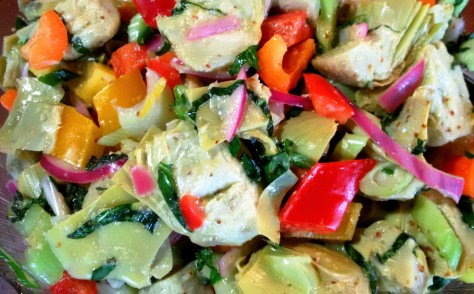Happy New Year! It’s a marvel to me that the year is 1/12th over. While I intend to savour every moment – I am also looking forward to the year 2020. It sounds so science-fiction-y!
Southern Ontario has had a mild winter until last week; now it has finally gotten serious. The cold is bitter and we have to start planning exactly where to pile the next snowfall. This season has many glories but to a cook it can be challenging. We love our roots but after a couple of months we miss the stimulation of summer’s progression of fresh produce. So we look elsewhere for inspiration. Canned artichoke hearts form the basis of this winter salad.

This is another salad for which I like to quick-pickle the onions. After a couple of hours of being tossed in vinegar, the colour softens and takes on a lovely blur. The taste loses some of its sharpness as well, a boon for those who aren’t raw onion fanatics.
ARTICHOKE HEART SALAD
2 to 3 hours before serving time, toss together…
1 medium red onion, sliced as thinly and as attractively as possible
1/4 c white wine vinegar
1 T maple syrup
1 t each of salt and black pepper
In a large bowl, assemble the salad ingredients …
3 cans (398 ml or 14 oz) of artichoke hearts – drained well and cut into quarters
2 medium peppers (red, yellow or orange) cut in a large dice
4 stalks celery, sliced thinly
1/2 bunch fresh basil, sliced in long, thin pieces (in a “chiffonade”)
(optional – 3 green onions, sliced thinly on a sharp angle … for those who need more onion in their lives)
When ready to serve, drain the vinegar from the red onion and add …
1 T grainy Dijon mustard
1/2 T minced garlic
Wisk in very slowly, to form an emulsion …
1/2 cup of good olive oil
Use this to dress the salad, tossing very gently to avoid having the artichoke hearts fall apart. Enjoy!
Incidentally, I was informed by a naturopath that the latest information indicates that to maximise the health benefits of garlic, it should be chopped finely and allowed to sit for 10 minutes before using. This allows the compound “allicin” to form and it is allicin that carries many of the health benefits. What really surprised me is that if the allicin is allowed to form in this manner, it will persist even when the garlic is then cooked! There are always so many things to learn …
Don’t forget that the first Taste of Diversity dinner is coming up fast on March 5. We will be visiting the Ukraine for this excursion but berths are popular and sell out quickly. Contact Pam at 519 824 1250 x 241 or officecoordinator@ignatiusguelph.ca
Thanks to Rose for this recipe (although I have taken some liberties with it) as well as our thanks for so much more.
Take care of yourselves so you can take care of each other. ❤